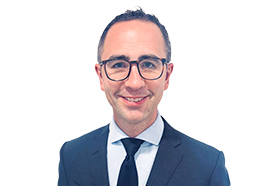Customer experience transformation at a global manufacturer
70
The Grant Thornton team identified, sequenced and prioritized 70 unique customer experiences.
30
The analysis aligned customer experiences to 30 organizational capabilities, ranked by potential impact.
10
The project took only 10 weeks to produce the analysis, recommendations and roadmap.
At a glance
Client
Global manufacturer
Industry
Manufacturing
Our role
Plan how to address customer needs
Our solution
Front-end tech strategy and plan
Scenario
A need to reduce friction for customers
A publicly traded global manufacturing company saw that it could win market share by offering streamlined customer experiences that meet current and future customer needs. The company was evaluating a digital transformation that would improve both its customer experiences and competitive differentiation.
“The company wanted to streamline the end-to-end customer experience,” said Grant Thornton Business Consulting Managing Director Mark Owens. However, the company had disconnected technology platforms across several sites due to a series of past business changes and strategies. That led to different customer experiences globally. “There had been a lot of M&A over the years, combined with various decisions that were driven by speed, urgency and localized relationships,” Owens said.
The company also had a disconnect between its growth-driven business strategy and its stability-driven technology strategy. “The IT organization was constructed to support the business from an ERP standpoint. IT was not operationally equipped to move at the speed of the needs of the business side, and it did not have the technology stack to ultimately support the evolving needs of customers,” Owens said.
The company needed a clear evaluation of its current technology stack behind the customer experience, along with resource estimates, cost estimates, vendor recommendations, and other insights to help prioritize and plan the path to its future vision.
Approach
Detailed analysis drives digital transformation
“The company asked us to evaluate their customer-facing technology stack and develop a plan to help reduce customer experience friction,” Owens said.
The Grant Thornton team identified key customer experiences, broke them down across persona groups, prioritized them, and aligned them to capabilities in the customer journey lifecycle. Then, the team ranked each capability by the level of effort and the impact on the customer experience. “The company had already done some customer journey work up front,” Owens said. “We were able to take that information, reduce that from scope, accelerate our own project, and then run through the remainder of our methodology and process.”
The team evaluated technology capabilities through a customer-centric lens. “We were working with both the company’s marketing and IT organizations,” Owens said. It was important to understand how various technology systems connected to enable customers. “The front-end experience involves how customers manage their accounts, purchase products, and then track or manage their products in the purchasing process. However, think about warehouse management or transportation management platforms — those might be back-end operational systems. But if you don’t know where orders are or when they’re going to arrive, then that hurts the customer experience.”
“We needed to think through some of the core components of the technology stack and have an informed conversation with IT counterparts about strengths, weaknesses and gaps,” Owens said. “The capabilities of the portfolio of applications underpinning the technology stack ultimately layer into the customer experience.” The team developed mappings that informed discussions and clarified needs across the enterprise.
To create the company’s future-state technology map, the team evaluated the company’s current technologies and then identified the new technologies required to enable capabilities and experience improvements. This analysis informed the team’s holistic view of the cost projections to deliver future-state customer experiences.
“We worked with both IT and business leadership on what the map and prioritization ought to be, developing business cases for specific applications and designing a roadmap that moved them forward,” Owens said.
The team’s roadmap and planning connected the technology initiatives, business initiatives and recommended vendors needed to achieve the targeted transformation and financial returns on investment. “We wanted to provide comprehensive input for business decision-making,” Owens said.
Result
Transformation for customer-centric growth
In just 10 weeks, the Grant Thornton team gave the manufacturer a clear view of the digital transformation needs, priorities, options, investments and roadmap required for its future-state customer experience.
The foundation for this information came from the team’s detailed customer analysis:
- Identified, codified and prioritized 70 unique customer experiences
- Aligned customer experiences to four persona groups
- Aligned customer experiences to 30 capabilities across the customer journey lifecycle
- Prioritized the 30 capabilities by level of transformation need and customer experience impact
“We adapted to and built upon the information the company had,” Owens said. “We don’t want to duplicate work where knowledge exists — we want to meet the client where they are, and then move them forward.”
The team turned this knowledge into specific recommendations, guidance and estimates, covering the landscape of PIM, CPQ, artificial intelligence capabilities, content management and other solutions. “It’s really how you manage digital experiences across channels and personalize for each customer,” Owens said. Cost projections gave leaders the information they needed to prioritize and budget. “We provided cost projections at each tier of the technology component stack — one-time upfront costs and then subscription ongoing costs, including the technology subscription, human capital investments, maintenance upgrades and more, with the ROI over three years.”
The long-term view of both the roadmap and the ROI gave the company clear insight for decisions. “Understanding the ROI associated with the tech investment is definitely core to this,” Owens said. “The prioritized technology roadmap had clear business cases that helped them to understand the ROI associated with specific applications or solutions at various points along the roadmap — and how those address pain points in the customer experience. That enabled a component of cost management, as well as an understanding of the ROI and payback associated with those costs or expenses.”
With a focus on customer-centric transformation, the company now had a path and plan to move forward.
“The company wanted to be easy for customers to do business with. At its essence, that means putting the customer at the center of your business strategy and then working backwards,” Owens said. “It creates better alignment, intention and purpose for employees at all levels. Now, when customer service receives a customer request, they want to streamline the customer experience. It drives alignment across the organization, resulting in a more positive, productive, efficient and focused organization that’s ready to meet the current and emerging needs of customers.”
Related resources
CASE STUDY
Connect with our team



Managing Director, Business Consulting
Grant Thornton Advisors LLC
Mark is a Managing Director in Grant Thornton’s Business Consulting practice, with a focus on Growth, Sales, Marketing, Customer Experience, Commercial Strategy, Digital Transformation and Business intelligence.
Philadelphia, Pennsylvania
Industries
- Asset Management
- Insurance
- Life Sciences
- Manufacturing, Transportation & Distribution
- Private Equity
- Retail & Consumer Brands
- Services
- Technology, Media & Telecommunications
Service Experience
- Advisory Services
- Business Consulting
Content disclaimer
This Grant Thornton Advisors LLC content provides information and comments on current issues and developments. It is not a comprehensive analysis of the subject matter covered. It is not, and should not be construed as, accounting, legal, tax, or professional advice provided by Grant Thornton Advisors LLC. All relevant facts and circumstances, including the pertinent authoritative literature, need to be considered to arrive at conclusions that comply with matters addressed in this content.
Grant Thornton Advisors LLC and its subsidiary entities are not licensed CPA firms.
For additional information on topics covered in this content, contact a Grant Thornton Advisors LLC professional.
Ready to talk? We’re ready to listen.
Request a meeting and a member of our team will be in touch to see what we can do to meet your needs.
Want to submit an RFP? Please submit your request through our RFP submission page.
Trending topics

No Results Found. Please search again using different keywords and/or filters.